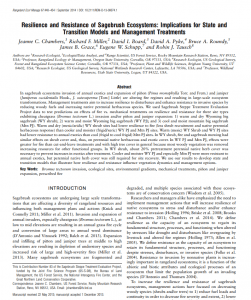Fire Ecology & Effects
View study.
Taken together, findings suggest that the response of stream chemistry to wildfires in the Sierra Nevada, California, can persist for years, varying with both fire severity and site-specific characteristics. These impacts may have important implications for biogeochemical cycles and productivity in aquatic ecosystems in fire-adapted landscapes.
View brief.
Strategically placed landscape area fuel treatments in the Sierra Nevada were put to the test in this study when the American Fire burned through previously treated areas. Both fire effects and initial post-fire conifer regeneration were investigated.
The following links are recordings of the presentations made by Working Lands for Wildlife researchers at The Wildlife Society’s 26th Annual Conference. This conference was in Reno, Nevada in October 2019. These videos are courtesy of The Wildlife Society and the USDA-NRCS Working Lands for Wildlife and Conservation Effect Assessment Project.
Cut a tree, grow a grouse: Implications of juniper removal for sage-grouse population growth
Sage-grouse: Microhabitat specialist or sagebrush generalist
Revolutionizing rangeland monitoring
Part 1 recordings.
Part 2 recordings.
Gambel oak (Quercus gambelii) is a widespread species found throughout the US Southwest and southern Rocky Mountains. While the species has been widely studied in Arizona and New Mexico, comparatively little is known about Gambel oak at the northern extent of its range (Colorado, Utah, southern Wyoming). Research in this geographic region is particularly important given substantial differences in growth form across the species’ range (tree vs. shrub), and because potential habitat for Gambel oak is likely to spread northward under future climate scenarios. In this webinar, we will discuss the current state of knowledge on the ecology and management of Gambel oak in the southern Rocky Mountains, with a focus on silviculture, wildfire, and post-fire.
View Volume 1
View Volume 2
Fifty years ago, riparian habitats were not recognized for their extensive and critical contributions to wildlife and the ecosystem function of watersheds. This changed as riparian values were identified and documented, and the science of riparian ecology developed steadily. Papers in this volume range from the more mesic northwestern United States to the arid Southwest and Mexico. More than two dozen authors – most with decades of experience – review the origins of riparian science in the western United States, document what is currently known about riparian ecosystems, and project future needs. Topics are widespread and include: interactions with fire, climate change, and declining water; impacts from exotic species; unintended consequences of biological control; the role of small mammals; watershed response to beavers; watershed and riparian changes; changes below large dams; water birds of the Colorado River Delta; and terrestrial vertebrates of mesquite bosques. Appendices and references chronicle the field’s literature, authors, “riparian pioneers,” and conferences.
Access webinar recording.
Millions of acres of fuels reduction treatments are being implemented each year in the fire adapted forests of the US. Typical these fuel reduction treatments target small diameter trees for removal producing large amounts of unmerchantable woody material and elevating surface fuel loadings. Often this material has no market value and is piled by hand or with heavy machinery and burned on site. We studied replicated experimental pile burns from two locations (Wenatchee, WA and Santa Clara, NM) over three years. We examined the effects of time since construction (i.e., pile age) and burn season (fall and spring) on fuel bed properties, combustion dynamics, fuel consumption, and charcoal formation for hand-constructed piles in thinned ponderosa pine-dominated sites. The webinar will also touch on pile decomposition rates and unplanned fire in areas with piled fuels.
View article.
Using a chronosequence approach, cover of vascular plants and biocrusts was examined across chronic disturbance gradients related to invasion by exotic species and grazing by livestock, following the acute disturbance of fire using paired burned and unburned plots in Wyoming big sagebrush on 99 plots. Results Cover of vascular plants and biocrusts was related to disturbance more so than abiotic factors of precipitation following fire, soil chemistry, percent coarse fragment and heat load index. Over time since fire of 12–23 years, we saw recovery of early successional groups: short mosses, shallow-rooted perennial grasses and annual forbs. Cover of deep and shallow-rooted perennial grasses and annual forbs increased in cover with intermediate levels of disturbance. Perennial forbs lacked a clear relationship with disturbance. Biocrusts decreased in cover with less disturbance when compared with perennial herbaceous plants but differed in sensitivities. Tall mosses were less sensitive to disturbance compared with lichens. Short mosses increased with some disturbance.
View report.
A group of people knowledgeable about wildland fire have produced a 52-page document that attempts to assemble and summarize areas of agreement and disagreement regarding the management of forested areas in the western United States. Calling themselves the Fire Research Consensus Working Group, they looked for areas of common ground to provide insights for scientists and land managers with respect to recent controversies over the role of low-, moderate-, and high-severity fires.
View article.
In sagebrush ecosystems invasion of annual exotics and expansion of pinyon and juniper are altering fire regimes and resulting in large-scale ecosystem transformations. Management treatments aim to increase resilience to disturbance and enhance resistance to invasive species by reducing woody fuels and increasing native perennial herbaceous species. This study used Sagebrush Steppe Treatment Evaluation Project data to test predictions on effects of fire vs. mechanical treatments on resilience and resistance for three site types. Warm (mesic) WY Shrub and WY PJ sites had lower resistance to annual exotics than cool (frigid to cool frigid) Mtn PJ sites. In WY shrub, fire and sagebrush mowing had similar effects on shrub cover and, thus, on perennial native herbaceous and exotic cover. In WY PJ and Mtn PJ, effects were greater for fire than cut-and-leave treatments and with high tree cover in general because most woody vegetation was removed increasing resources for other functional groups. In WY shrub, about 20% pretreatment perennial native herb cover was necessary to prevent increases in exotics after treatment. Cooler and moister WY PJ and especially Mtn PJ were more resistant to annual exotics, but perennial native herb cover was still required for site recovery. We use our results to develop state and transition models that illustrate how resilience and resistance influence vegetation dynamics and management options.
Want to beef-up your library? You can request the following resources in hard copy from Génie (listed in order of most recent publication date). You can also add them to your electronic library, just follow the links for downloads.
Fire patterns in piñon and juniper land cover types in the Semiarid Western United States from 1984 through 2013, 2018. RMRS-GTR-372
Restoration handbook for sagebrush steppe ecosystems with emphasis on greater sage-grouse habitat—Part 3. Site level restoration decisions, 2018. USGS Circular 1426
Science framework for conservation and restoration of the sagebrush biome: Linking the Department of the Interior’s Integrated Rangeland Fire Management Strategy to long-term strategic conservation actions, 2017. RMRS-GTR-360
Pocket Guide to Sagebrush Birds, reprint, 2017. A partnership between Rocky Mountain Bird Observatory and PRBO Conservation Science
Pocket Guide to Sagebrush, reprint, 2017. Made possible by USU, NRCS, USFS, BLM, PRBO Conservation Science, NDOW, GBFSE
Ecohydrologic impacts of rangeland fire on runoff and erosion: A literature synthesis, 2016. RMRS-GTR-351
Using resilience and resistance concepts to manage threats to sagebrush ecosystems, Gunnison sage-grouse, and Greater sage-grouse in their eastern range: A strategic multi-scale approach, 2016. RMRS-GTR-356
A field guide for rapid assessment of post-wildfire recovery potential in sagebrush and pinon-juniper ecosystems in the Great Basin: Evaluating resilience to disturbance and resistance to invasive annual grasses and predicting vegetation response, 2015. RMRS-GTR-338
A review of fire effects on vegetation and soils in the Great Basin Region: Response and site characteristics, 2013. RMRS-GTR-308






